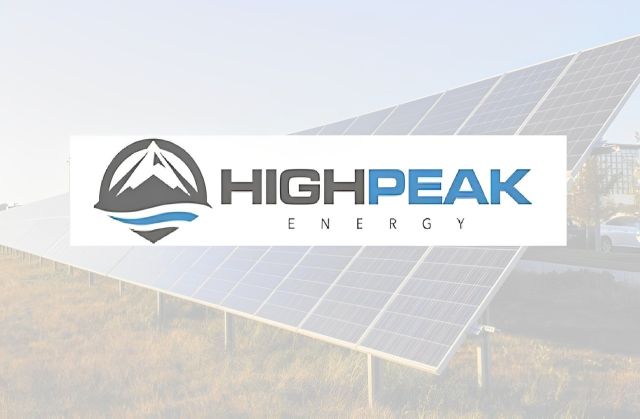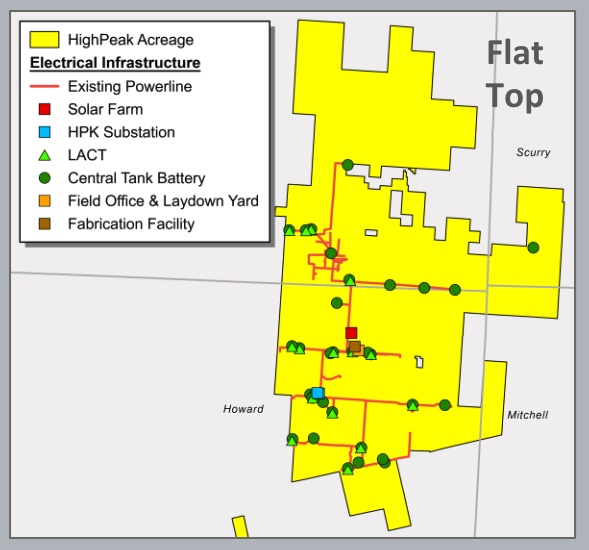
HighPeak has turned to solar energy in the Permian Basin, while others have turned to wind. (Source: Shutterstock/ HighPeak Energy)
Midland Basin oil producer HighPeak Energy and Priority Power have commissioned the nearly 10-megawatt (MW) WildHorse Solar Farm in the Flat Top operating area in Texas, the companies said May 30.
Developed and owned by Priority Power, the facility in Howard County is expected to produce enough electricity to power nearly 3,700 homes and reduce more than 18 million metric tons (MMmt) of CO2 emissions. Electricity generated at the solar farm will power HighPeak’s operations, a move the company says will lower costs and minimize greenhouse gas emissions.
“The 10 megawatts generated from this project will reduce our power costs, shield us from summer spot power price spikes and reduce our carbon footprint,” HighPeak President Mike Hollis said in a statement. “HighPeak has been energizing our drilling rigs with grid power, and we are now drilling with power directly supplied by West Texas sunshine.”
Completion and commissioning of the solar farm came as power needs in the Permian Basin continue to surge, operators diversify their power sources and as competition for power—including from data centers and bitcoin miners—heats up along with temperatures and prices.
Grid interconnection challenges are increasingly leading some oil and gas companies to seek other energy sources and behind-the-meter solutions.
HighPeak has turned to solar energy in the Permian Basin, while others have turned to wind. NextEra Energy, for example, worked with Pioneer Natural Resources Co.—now part of Exxon Mobil Corp.—and Targa Resources to develop a 140-MW wind generation facility in Midland County. The 51-turbine wind farm, called Pioneer Hutt Wind Energy Center, was commissioned earlier this year.
Other Permian players could utilize small nuclear reactors to power operations. California-headquartered Oklo Inc., a fission power plant developer, in April said it signed a letter of intent with Diamondback Energy to collaborate on a 20-year power purchase agreement. The agreement focuses on the use of Oklo’s Aurora powerhouses, which are scalable liquid metal-cooled, metal-fueled fast reactors that generate usable heat and between 15 MW and 50 MW of electricity.
RELATED
Diamondback May Go Nuclear to Power Permian Basin Ops
Big Demand Means Big Challenges Ahead for Power Sector
Texas’ ERCOT Power Needs to Nearly Double Over Next Six Years
The projected load demand in the Permian Basin area served by the Electric Reliability Council of Texas (ERCOT) could rise to 17.2 gigawatts (GW) by 2032, up from 4.2 GW in 2022, according to an S&P Global report on electrification in the basin. Electricity is being used to not only power artificial lift and well pad production facility, it’s also being used to power pumps for water handling and gathering systems.
But the oil and gas sector is not the only one seeking more power.
“Every large energy user is competing for the next electron, including oil and gas operators, traditional businesses, hyperscale datacenters and new energies such as hydrogen plants alike,” Priority Power CEO Brandon Schwertner said in a news release. “Just this year, the value of 100 megawatts of power over the next 10 years has already moved $100 million dollars higher, and the pressure remains for more escalation.”

In addition to managing the interconnection process for WildHorse, Priority Power’s scope of work included providing the turnkey design, building, engineering, procuring and constructing the wind farm.
“This project exemplifies HighPeak’s commitment to being a sustainable operator while delivering shareholder value,” said Danny Smedley, managing director and vice president of Priority Power. “At a time when power prices in Texas are very volatile, the WildHorse Solar Farm has the added benefit of reducing HighPeak’s operating expenses while providing clean, reliable power.”
HighPeak formed a partnership with the independent energy services provider in 2021.
Recommended Reading
Ovintiv Closes Montney Acquisition, Completing $4.3B in M&A
2025-02-02 - Ovintiv closed its $2.3 billion acquisition of Paramount Resource’s Montney Shale assets on Jan. 31 after divesting Unita Basin assets for $2 billion last week.
Matador Exits Eagle Ford Shale, Preps for ‘Turbulent Times’
2025-04-04 - Matador Resources Co. divested its Eagle Ford Shale assets “in preparation for turbulent times” but doesn’t expect tariffs to affect well costs until the second half of 2025.
Crescent Energy Closes $905MM Acquisition in Central Eagle Ford
2025-01-31 - Crescent Energy’s cash-and-stock acquisition of Carnelian Energy Capital Management-backed Ridgemar Energy includes potential contingency payments of up to $170 million through 2027.
Petro-Victory Buys Oil Fields in Brazil’s Potiguar Basin
2025-02-10 - Petro-Victory Energy is growing its footprint in Brazil’s onshore Potiguar Basin with 13 new blocks, the company said Feb. 10.
Apollo Funds Acquires NatGas Treatment Provider Bold Production Services
2025-02-12 - Funds managed by Apollo Global Management Inc. have acquired a majority interest in Bold Production Services LLC, a provider of natural gas treatment solutions.
Comments
Add new comment
This conversation is moderated according to Hart Energy community rules. Please read the rules before joining the discussion. If you’re experiencing any technical problems, please contact our customer care team.






